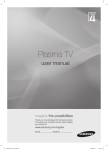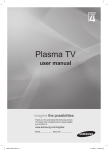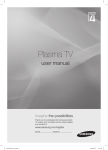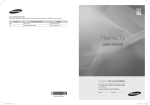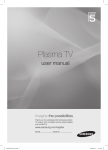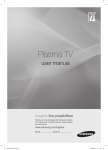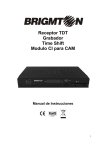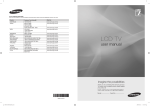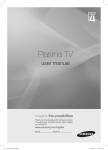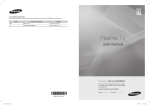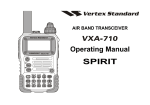Download Samsung PS50B450B1M User Manual
Transcript
Plasma TV user manual imagine the possibilities Thank you for purchasing this Samsung product. To receive more complete service, please register your product at www.samsung.com/register Model BN68-02014A-Eng.indd 1 Serial No. 2009-09-18 �� 9:19:49 User Instructions Screen Image retention Do not display a still image (such as on a video game or when hooking up a PC to this PDP) on the plasma monitor panel for more than 2 hours as it can cause screen image retention. This image retention is also known as “screen burn”. To avoid such image retention, reduce the degree of brightness and contrast of the screen when displaying a still image. Height The PDP can normally operate only under 2000m in height. It might abnormally function at a place over 2000m in height so do not install and operate there. Heat on the top of the PDP TV The top side of the product may be hot after long period of use as heat dissipates from the panel through the vent hole in the upper part of the product. This is normal and does not indicate any defect or operation failure of the product. However, children should be prevented from touching the upper part of the product. The product is making a ‘cracking’ noise. A ‘cracking’ noise may occur when the product contracts or expands due to a change of surrounding environment such as temperature or humidity. This is normal and not a defect of the unit. Cell Defects The PDP uses a panel consisting of 2,360,000(HD-level) to 6,221,000(FHD-level) pixels which require sophisticated technology to produce. However, there may be few bright or dark pixels on the screen. These pixels will have no impact on the performance of the product. Avoid operating the TV at temperatures below 5°C(41°F) A still image displayed too long may cause permanent damage to the PDP Panel. Watching the PDP TV in 4:3 format for a long period of time may leave traces of borders displayed on the left, right and centre of the screen caused by the difference of light emission on the screen. Playing a DVD or a game console may cause similar effect to the screen. Damages caused by the above effect are not covered by the Warranty. Afterimage on the Screen. Displaying still images from Video games and PC for longer than a certain period of time may produce partial afterimages. To prevent this effect, reduce the ‘brightness’ and ‘contrast’ when displaying still images. Warranty -- Warranty does not cover any damage caused by image retention. -- Burn-in is not covered by the warranty. Installation Be sure to contact an authorized service centre, when installing your set in a location with heavy dust, high or low temperatures, high humidity, chemical substance and where it operates continually such as the airport, the train station etc. Failure to do so may cause a serious damage to your set. Digital TV (DVB-T) Notice 1. Functionalities related to Digital TV(DVB) are only available in countries/areas where DVB-T (MPEG2 and MPEG4 AVC) digital terrestrial signals are broadcasted or where you have access to a compatible DVB-C(MPEG2 and MPEG4 AAC) cable-TV service. Please check with your local dealer the possibility to receive DVB-T or DVB-C signal. 2. DVB-T is the DVB European consortium standard for the broadcast transmission of digital terrestrial television and DVB-C is that for the broadcast transmission of digital TV over cable. However, some differentiated features like EPG (Electric Program Guide), VOD (Video on Demand) and so on, are not included in this specification. So, they cannot be supported at this moment. 3. Although this TV set meets the latest DVB-T and DVB-C standards[August,2008], the compatibility with future DVB-T digital terrestrial and DVB-C digital cable broadcasts cannot be guaranteed. 4. Some cable-TV providers may charge an additional fee for such a service and you may be required to agree to terms and conditions of their business. 5. Some Digital TV functions might be unavailable in some countries or regions and DVB-C might not work correctly with all providers. 6. For more information, please contact your local Samsung customer care centre. © 2009 Samsung Electronics Co., Ltd. All rights reserved. English - 2 BN68-02014A-Eng.indd 2 2009-09-18 �� 9:19:49 Contents Connecting and Preparing Your TV Function Description ■■ Checking Parts........................................................................... 4 ■■ Using the Stand-Base................................................................ 4 ■■ How to assemble the Stand-Base (depending on the model).... 4 ■■ Viewing the Control Panel.......................................................... 5 ■■ Viewing the Connection Panel................................................... 6 ■■ Remote Control.......................................................................... 7 ■■ Installing Batteries in the Remote Control.................................. 8 ■■ Switching On and Off................................................................. 8 ■■ Placing Your Television in Standby Mode. ................................. 8 ■■ Viewing the Menus..................................................................... 9 ■■ Using the TOOLS Button. .......................................................... 9 ■■ Plug & Play Feature................................................................. 10 ■■ Configuring the Setup Menu.................................................... 23 ■■ Setting the Time....................................................................... 25 ■■ Source List / Edit Name........................................................... 26 ■■ Supported Program.................................................................. 27 About Anynet+ ■■ Connecting Anynet+ Devices................................................... 28 ■■ Setting Up Anynet+ ................................................................. 29 ■■ Scanning and Switching between Anynet+ Devices................ 29 ■■ Recording................................................................................. 30 ■■ Listening through a Receiver (Home theater).......................... 31 ■■ Troubleshooting for Anynet+ ................................................... 31 Channel Control Recommendations for Use ■■ Storing Channels . .................................................................. 11 ■■ Managing Channels................................................................. 13 ■■ Teletext Feature....................................................................... 32 ■■ Wall Mount Kit Specifications (VESA)...................................... 33 ■■ Preparing before installing Wall- Mount on the wall................. 34 ■■ Securing the TV to the Wall. .................................................... 34 ■■ Securing the Installation Space. .............................................. 35 ■■ Troubleshooting. ...................................................................... 36 ■■ Specifications........................................................................... 39 Picture Control ■■ Changing the Picture Settings. ................................................ 15 ■■ Using the 3D Function. ............................................................ 18 ■■ Setting up the TV with your PC................................................ 19 ■■ PC Display............................................................................... 20 Sound Control ■■ Changing the Sound Setting.................................................... 21 ■■ Selecting the Sound Mode....................................................... 22 Symbol Press N O T Note One-Touch Button TOOLS English - 3 BN68-02014A-Eng.indd 3 2009-09-18 �� 9:19:49 Connecting and Preparing Your TV Checking Parts Owner’s Instructions Remote Control/ AAA Batteries (2ea) Power Cord Cloth-Clean Screw (4ea) Cover-Bottom Holder-Ring (4ea) (Refer to page 34) Ferrite Core for Power Cord (2ea) Warranty Card/ Safety Guide Manual (Not available in all locations) NN The ferrite core is used to shield the cable from interference. When connecting a cable, open the ferrite core and clip it around the cable near the plug as shown in the figure. Using the Stand-Base NN Two or more people should carry the PDP. Never lay the PDP on the floor because of possible damage to the screen. Always keep the PDP upright. NN The PDP can rotate 20 degrees in right and left directions. -20° ~ 20° How to assemble the Stand-Base (depending on the model) Using the 4 screws for securing the stand base and the monitor, firmly attach the monitor to the stand base. (The exterior of the set may be different than the picture.) In case of installing your TV on the wall, close the cover (1) on the stand-base connection part using two screws for hiding. Warning Firmly secure the stand to the TV before moving it, as the stand may fall and could cause serious injury. NN Two or more people should carry the TV. Never lay the TV on the floor because of possible damage to the screen. Always store the TV upright. English - 4 BN68-02014A-Eng.indd 4 2009-09-18 �� 9:19:52 Viewing the Control Panel Front Panel buttons NN The product colour and shape may vary depending on the model. 1 SOURCE Toggles between all the available input sources (TV, AV, Component 1, Component 2, PC, HDMI1, HDMI2/DVI, HDMI3). NN In the on-screen menu, use this button as you would use the ENTERE button on the remote control. 2 MENU Press to see an on-screen menu of your TV’s features. 3 + VOL – Press to increase or decrease the volume. In the on-screen menu, use the + VOL – buttons as you would use the ◄ and ► buttons on the remote control. Touch each button to operate. 4 < CH > Press to change channels. In the on-screen menu, use the < CH > buttons as you would use the ▲ and ▼ buttons on the remote control. 5 (POWER) Press to turn the TV on and off. 6 POWER INDICATOR Lights up when the power is on. 7 REMOTE CONTROL SENSOR Aim the remote control towards this spot on the TV. 8 SPEAKERS English - 5 BN68-02014A-Eng.indd 5 2009-09-18 �� 9:19:53 Viewing the Connection Panel TV Rear Panel TV Side Panel 1 or 9 Cable Television Network 2 or 3 4 5 1 6 7 0 8 NN The product colour and shape may vary depending on the model. NN Whenever you connect an audio or video system to your set, ensure that all elements are switched off. NN When connecting an external device, match the colour of the connection terminal to the cable. 1 SERVICE 1, 2 Connector for service. 2 POWER IN Connect the supplied power cord. 3 PC IN(PC) / (AUDIO) Connect to the video and audio output jack on your PC. 4 COMPONENT IN 1, 2 Audio (AUDIO L/R) and video (Y/PB/PR) inputs for Component. 5 DIGITAL AUDIO OUT (OPTICAL) Connect to a Digital Audio Component. 6 3D SYNC OUT Connect to 3D IR Emitter 7 AUDIO OUT(AUDIO R/L) Connect RCA audio signals from the TV to an external source, such as Audio equipment. 8 HDMI IN 1, 2 (DVI) , 3 -- No additional Audio connection is needed for an HDMI to HDMI connection. -- When using an HDMI/DVI cable connection, you must use the HDMI IN 2 (DVI) jack. NN What is HDMI? -- High Definition Multimedia interface allows the transmission of high definition digital video data and multiple channels of digital audio. -- The HDMI/DVI terminal supports DVI connection to an extended device with the appropriate cable (not supplied). The difference between HDMI and DVI is that the HDMI device is smaller in size, has the HDCP (High Bandwidth Digital Copy Protection) coding feature installed, and supports multi - channel digital audio. DVI IN / AUDIO IN DVI audio outputs for external devices. 9 ANT IN 75Ω Coaxial connector for Aerial/Cable Network. 0 AV IN (VIDEO / AUDIO R/L) Video and audio inputs for external devices, such as a camcorder or VCR. Supported modes for HDMI/DVI and Component HDMI/DVI 50Hz HDMI/DVI 60Hz Component 480i X X O 480p X O O 576i X X O 576p O X O 720p 1080i 1080p O O O O O O O O O English - 6 BN68-02014A-Eng.indd 6 2009-09-18 �� 9:19:55 Remote Control You can use the remote control up to a distance of about 23 feet from the TV. NN The performance of the remote control may be affected by bright light. 1 POWER button (turns the TV on and off) 2 Selects the TV mode directly. 3 Number buttons for direct channel access 4 Use to Select on-screen menu items 5 Temporary sound switch-off Volume increase Volume decrease 7 Available source selection 8 Channel control button 9 Use to quickly select frequently used functions. 0 Control the cursor in the menu ! Use to see information on the current broadcast @ Use these buttons in the Channel list, etc. $ Sound mode selection % Use these buttons in the Channel list, and Anynet+. ^ Previous channel 6 Teletext Functions 2 Exit from the teletext display (depending on the model) 7 Teletext mode selection (LIST/FLOF) 8 Teletext store 9 Teletext size ! Teletext reveal @ Fastext topic selection # Teletext display/mix both teletext information and the normal broadcast ^ Teletext sub page : Teletext next page & P P : Teletext previous page * Teletext index ) Teletext hold a Teletext cancel Next channel Previous channel * Displays the main on-screen menu ( Displays the favourites channel list. ) Returns to the previous menu a Exit the on-screen menu b Selects SRS TruSurround HD mode. c Picture size selection d Digital subtitle display e This is used to activate the EPG icon function in the MHEG (Multimedia and Hypermedia Coding Expert Group). & English - 7 BN68-02014A-Eng.indd 7 2009-09-18 �� 9:19:55 Installing Batteries in the Remote Control 1. Lift the cover at the back of the remote control upward as shown in the figure. 2. Install two AAA size batteries. NN Make sure to match the ‘+’ and ‘–’ ends of the batteries with the diagram inside the compartment. 3. Close the cover. NN Remove the batteries and store them in a cool, dry place if you won’t be using the remote control for a long time. NN If the remote control doesn’t work, check the following 1. Is the TV power on? 2. Are the plus and minus ends of the batteries reversed? 3. Are the batteries drained? 4. Is there a power outage or is the power cord unplugged? 5. Is there a special fluorescent light or neon sign nearby? Switching On and Off The mains lead is attached to the rear of your set. 1. Plug the mains lead into an appropriate socket. NN The standby indicator lights up on your set. 2. Press the POWERP button on your set. NN You also can press the POWERP button or the TV button on the remote control to turn the TV on. The programme that you were watching last is reselected automatically. 3. Press the numeric button (0~9) or channel up / down (< / >) button on the remote control or < CH > button on your set. NN When you switch the set on for the very first time, you will be asked to choose language in which the menus are to be displayed. 4. To switch your set off, press the POWERP button again. Placing Your Television in Standby Mode Your set can be placed in standby mode in order to reduce the power consumption. The standby mode can be useful when you wish to interrupt viewing temporarily (during a meal, for example). 1. Press the POWERP button on the remote control. NN The screen is turned off and a red standby indicator appears on your set. 2. To switch your set back on, simply press the POWERP, numeric buttons (0~9), TV button or channel up / down (< / >) button again. NN Do not leave your set in standby mode for long periods of time (when you are away on holiday, for example). It is best to unplug the set from the mains and aerial. English - 8 BN68-02014A-Eng.indd 8 2009-09-18 �� 9:19:56 Viewing the Menus NN The on-screen menus disappear from the screen after about one minute. Picture 1. With the power on, press the MENU button. The main menu appears on the screen. The menu’s left side has icons: Picture, Sound, Channel, Setup, Input, Application, Support. 2. Press the ▲ or ▼ button to select one of the icons. Then press the ENTERE button to access the icon’s sub-menu. 3. Press the EXIT button to exit. Mode : Standard Cell Light :4 Contrast : 95 Brightness : 45 Sharpness : 50 Colour : 50 Tint (G/R) : G50/R50 Using the TOOLS Button You can use the TOOLS button to select your frequently used functions quickly and easily. The Tools menu changes depending on which external input mode you are viewing. 1. Press the TOOLS button. The Tools menu will appear. 2. Press the ▲ or ▼ button to select a menu, then press the ENTERE button. 3. Press the ▲ / ▼ / ◄ / ► / ENTERE buttons to display, change, or use the selected items. For a more detailed description of each function, refer to the corresponding page. •• •• •• •• •• •• •• Anynet+ (HDMI-CEC), see page 29 Picture Mode, see page 15 Sound Mode, see page 21 Sleep Timer, see page 25 Energy Saving, see page 24 Add to Favourite (or Delete from Favourite), see page 13 Auto Adjustment, see page 19 Tools Anynet+ (HDMI-CEC) Picture Mode : Standard Sound Mode : Custom Sleep Timer : Off Energy Saving : Off Add to Favourite U Move E Enter e Exit English - 9 BN68-02014A-Eng.indd 9 2009-09-18 �� 9:19:56 Plug & Play Feature When the TV is initially powered on, basic settings proceed automatically and subsequently. NN The Screen Saver is activated if there is no remote control key input for longer than 1 minute while Plug & Play is running. NN The Screen Saver is activated if there is no operating signal for longer than 15 minutes. 1. Press the POWER button on the remote control. The message Select 'Home Use' when installing this TV in your home. is displayed. 2. Press the ◄ or ► button to select Store Demo or Home Use, then the ENTERE button. Plug & Play Select ‘Home Use’ When installing this TV in your home Store Demo NN We recommend setting the TV to Home Use mode for the best picture in your Home Use L Move E Enter home environment. NN Store Demo mode is only intended for use in retail environments. NN If the unit is accidentally set to Store Demo mode and you want to return to Home Use (Standard): Press the Volume button on the TV. When the volume OSD is displayed, press and hold the MENU button on the TV for 5 seconds. NN The factory default setting for the picture will be Standard. Standard mode is the recommended home viewing picture mode. 3. Select country. menu is displayed. Press the ENTERE. Select the appropriate country by pressing the ▲ or ▼ button. Press the ENTERE button to confirm your choice. 4. Press the ▲ or ▼ button to select the Antenna source to memorize. Press the ENTERE button to select Start. •• Digital & Analogue: Digital and Analogue channels. •• Digital: Digital channels. •• Analogue: Analogue channels. NN The channel search will start and end automatically. NN Press the ENTERE button at any time to interrupt the memorization process. NN After all the available channels are stored, the message Set the Clock Mode. is displayed. 5. Press the ENTERE button. Press the ▲ or ▼ button to select Auto, then Press the ENTERE button. NN If you select Manual, Set current date and time is displayed. (refer to page 25) NN If you have received a digital signal, the time will be set automatically. If not, see page 25 to set the clock. 6. The brief instruction on How to get the best performance from your new HDTV is displayed. Press the ENTERE button. NN This menu is available HD Connection Guide in the Support menu. 7. The message Enjoy your TV is displayed. When you have finished, press the ENTERE button. If you want to return to this feature... NN The Plug & Play feature is only available in the TV mode. NN Any previous settings and adjustments will remain including the picture mode. All Channel settings will be lost. For home viewing, ensure the picture mode is set to Standard. Setup 1. Press the MENU button to display the menu. Press the ▲ or ▼ button to select Setup, then press the ENTERE button. 2. Press the ENTERE button again to select Plug & Play. 3. Enter your 4 digit PIN number. The default PIN number of a new TV set is ‘0-0-0-0’. NN If you want to change PIN number, refer to 23 page. Plug & Play ► Time Game Mode : Off Child Lock : On Change PIN Parental Lock Subtitle English - 10 BN68-02014A-Eng.indd 10 2009-09-18 �� 9:19:56 Channel Control Storing Channels ❑❑ Country Channel You can change the desired country. NN The PIN number input screen appears. Enter your 4 digit PIN number. ❑❑ Auto Store Country : New Zealand ► Auto Store Manual Store Scans for all channels with active broadcast stations (and availability depends on your country) and stores them in the TV's memory. You can memorize the Antenna source. •• Digital & Analogue: Digital and Analogue channels. •• Digital: Digital channels. •• Analogue: Analogue channels. NN If you want to stop Auto Store, press the ENTERE button. NN The Stop Auto Store? message will be displayed. NN Select Yes by pressing the ◄ or ► button, then press the ENTERE button. NN If a channel is locked using the Child Lock function, the PIN input window appears. Channel List Fine Tune ❑❑ Manual Store Scans for a channel manually and stores it in the TV’s memory. NN If a channel is locked using the Child Lock function, the PIN input window appears. Digital Channel Manual store for digital channels. NN Digital Channel is only availe in DTV mode. •• Channel: Set the Channel number using the ▲, ▼ or number (0~9) buttons. •• Frequency: Set the frequency using the number buttons. •• Bandwidth: Set the bandwidth using the ▲, ▼ or number (0~9) buttons. NN When it has finished, channels are updated in the channel list. Analogue Channel (only analogue channel) Manual store for analogue channel. •• Programme (Programme number to be assigned to a channel): Sets the programme number using the ▲, ▼ or number (0~9) buttons. •• Colour System → Auto / PAL / SECAM / NTSC4.43: Sets the colour system value using the ▲ or ▼ button. •• Sound System → BG / DK / I / L : Sets the sound system value using the ▲ or ▼ button. •• Channel (When you know the number of the channel to be stored): Press the ▲ or ▼ button to select C (Air channel) or S (Cable channel). Press the ► button, then press the ▲, ▼ or number (0~9) buttons to select the required number. NN You can also select the channel number directly by pressing the number (0~9) buttons. NN If there is abnormal sound or no sound, reselect the sound standard required. •• Search (When you do not know the channel numbers): Press the ▲ or ▼ button to start the search. The tuner scans the frequency range until the first channel or the channel that you selected is received on the screen. •• Store (When you store the channel and associated programme number): Set to OK by pressing the ENTERE button. NN Channel mode -- C (Air channel mode): You can select a channel by entering the assigned number to each air broadcasting station in this mode. -- S (Cable channel mode): You can select a channel by entering the assigned number for each cable channel in this mode. English - 11 BN68-02014A-Eng.indd 11 2009-09-18 �� 9:19:57 ❑❑ Channel List For the detailed procedures on using the Channel List, refer to the descriptions on pages 13~14. ❑❑ Channel Mode When the P (< / >) button is pressed, Channels will be switched within the selected channel list. Added Ch.: Channels will be switched within the memorized channel list. Favourite Ch.: Channels will be switched within the favourite channel list. ❑❑ Fine Tune (only analogue channels) If the reception is clear, you do not have to fine tune the channel, as this is done automatically during the search and store operation. If the signal is weak or distorted, you may have to fine tune the channel manually. NN Fine tuned channels that have been saved are marked with an asterisk * on the right-hand side of the channel number in the channel banner. NN If you do not store the fine-tuned channel in memory, adjustments are not saved. NN To reset the fine-tuning, select Reset by pressing the ▼ button and then press the ENTERE button. English - 12 BN68-02014A-Eng.indd 12 2009-09-18 �� 9:19:57 Managing Channels NN Select a channel in the All Channels, Added Channels, Favourites, or Programmed screen by pressing the ▲ / ▼ buttons, and pressing the ENTERE button. Then you can watch the selected channel. Auto Store Manual Store Channel Using this menu, you can add / delete or set favourite channels and use the programme guide for digital broadcasts. Channel List Channel Mode : Added Ch. Fine Tune •• All Channels: Shows all currently available channels. •• Added Channels: Shows all added channels. •• Favourites: Shows all favourite channels. ----- Red (Channel Type): Toggle between your TV, Radio, Data / Other and All. Green (Zoom): Enlarges or shrinks a channel number. Yellow (Select): Selects multiple channel lists. T TOOLS (Tools): Displays the Delete (or Add), Add to Favourite (or Delete from Favourite), Timer Viewing, Edit Channel Name, Edit Channel Number, Sort, Lock (or Unlock), Select All, Deselect All, or Auto Store menu. (The Options menus may differ depending on the situation.) Added Channels •• Programmed: Shows all current reserved programmes. NN Using the Colour buttons with the Channel List 20 21 ABC HDTV ABC2 C -- A 0 1 C -A 2 ♥C -A 3 C -A 4 C -A 5 C -A 6 C -A 7 C -A All NN Channel Status Display Icons Channel Type Zoom Select A An Analogue channel. c A channel selected by pressing the yellow button. ♥ A channel set as a Favourite. ( A programme currently being broadcast. \ A locked channel. ) A reserved programme Tools ❑❑ Channel List Tools Menu (in All Channels / Added Channels / Favourites) Add / Delete You can delete or add a channel to display the channels you want. NN All deleted channels will be shown on All Channels menu. NN A gray-coloured channel indicates the channel has been deleted. NN The Add menu only appears for deleted channels. NN You can also delete a channel to the Added Channels or Favourite menu in the same manner. All Channels NN Press the TOOLS button to use the tools menu. NN Option menu items may differ depending on the channel status. 20 21 ABC HDTV ABC2 C -- All A 0 1 C -A 2 C -A 3 C -A 4 C -A 5 C -A 6 C -A 7 C -A Delete Add to Favourite Timer Viewing Edit Channel Name Sort Lock ▼ Channel Type Zoom Select Tools Add to Favourite / Delete from Favourite You can set channels you watch frequently as favourites. TT Press the TOOLS button to display Tools menu. You can also add the favourite channel by selecting Tools → Add to Favourite (or Delete from Favourite). NN The “♥” symbol will be displayed and the channel will be set as a favourite. NN All favourite channels will be shown on Favourite menu. Timer Viewing If you reserve a programme you want to watch, the channel is automatically switched to the reserved channel in the Channel List; even when you are watching another channel. To reserve a programme set the current time first. (See page 25) NN Only memorized channels can be reserved. NN You can set the channel, month, day, year, hour and minute directly by pressing the number buttons on the remote control. NN Reserving a programme will be shown on Programmed menu. NN Digital Programme Guide and Viewing Reservation When a digital channel is selected, and you press the ► button, the Programme Guide for the channel appears. You can reserve a programme according to the procedures described above. English - 13 BN68-02014A-Eng.indd 13 2009-09-18 �� 9:19:57 Edit Channel Name (only analogue channel) Channels can labeled so that their call letters appear whenever the channel is selected. NN The names of digital broadcasting channels are automatically assigned and cannot be labeled. Edit Channel Number (only digital channel) You can also edit the channel number by pressing the number buttons on the remote control. Sort (only analogue channel) This operation allows you to change the programme numbers of the stored channels. This operation may be necessary after using the auto store. Lock / Unlock You can lock a channel so that the channel cannot be selected and viewed. This function is available only when the Child Lock is set to On. (see page 23) NN The PIN number input screen appears. Enter your 4 digit PIN number. NN The default PIN number of a new TV set is '0-0-0-0'. You can change the PIN, by selecting Change PIN from the menu. NN The “\” symbol will be displayed and the channel will be locked. Select All / Deselect All Programmed •• Select All: You can select all the channels in the channel list. •• Deselect All: You can deselect all the selected channels in the channel list. NN You can perform the add / delete, add to Favourites / delete from Favourites, or lock / unlock function for multiple channels at the same time. Select the required channels and press the yellow button to set all the selected channels at the same time. NN The c mark appears to the left of the selected channels. NN You can only select Deselect All when there is a selected channel. 1 / 1 / 2009 Auto Store NN For further details on setting up Tools, refer to page 11. NN If a channel is locked using the Child Lock function, the PIN input window appears. 13:59 5 18:59 2 20:59 2 21:59 2 ChangeQuincy, Info M.E TV1 Cancel Schedules TV3 The Equalizer Information TV3 McMillan & Wife Select All TV3 M.Spillane’s mike Hammer ❑❑ Channel List Option Menu (in Programmed) You can view, modify or delete a reservation. NN Press the TOOLS button to use the tools menu. Zoom Select Tools Information Change Info Select to change a viewing reservation. Cancel Schedules Select to cancel a viewing reservation. Information Select to view a viewing reservation. (You can also change the reservation information.) Select All / Deselect All You can select (or deselect) all channels in the channel list. English - 14 BN68-02014A-Eng.indd 14 2009-09-18 �� 9:19:57 Picture Control Changing the Picture Settings ❑❑ Mode Picture You can select the type of picture which best corresponds to your viewing requirements. •• Dynamic: Selects the picture for high-definition in a bright room. •• Standard: Selects the picture for the optimum display in a normal environment. •• Movie: Selects the picture for viewing movies in a dark room. TT Press the TOOLS button to display Tools menu. You can also set the picture mode by selecting Tools → Picture Mode. ❑❑ Cell Light / Contrast / Brightness / Sharpness / Colour / Tint (G/R) Mode : Standard Cell Light :4 Contrast : 95 Brightness : 45 Sharpness : 50 Colour : 50 Tint (G/R) : G50/R50 ► Your television has several setting options that allow you to control the picture quality. •• Cell Light: Adjusts the pixel brightness. •• Contrast: Adjusts the contrast level of the picture. •• Brightness: Adjusts the brightness level of the picture. •• Sharpness: Adjusts the edge definition of the picture. •• Colour: Adjusts Colour saturation of the picture. •• Tint (G/R): Adjusts the Colour tint of the picture. NN Select a picture mode to be adjusted first. The adjusted values are saved for each picture mode. NN When you make changes to Cell Light, Contrast, Brightness, Sharpness, Colour, or Tint (G/R), the OSD will be adjusted accordingly. NN In Analogue TV, AV modes of the PAL system, you cannot use the Tint Function. NN In PC mode, you can only make changes to Cell Light, Contrast and Brightness. NN Settings can be adjusted and stored for each external device you have connected to an input of the TV. NN The energy consumed during use can be significantly reduced if the level of brightness of the picture is reduced, and then this will reduce the overall running cost. ❑❑ Advanced Setting You can adjust the detailed settings for your screen including the color and contrast. among the Advanced Setting items. Picture NN Advanced Setting is available in Standard or Movie mode. NN In PC mode, you can only make changes to Gamma and White Balance from Colour : 50 Tint (G/R) : G50/R50 Advanced Setting ► Picture Options Picture Reset Black Tone → Off / Dark / Darker/ Darkest You can select the black level on the screen to adjust the screen depth. Dynamic Contrast → Off / Low / Medium / High You can adjust the screen contrast so that the optimal contrast is provided. Gamma You can adjust the primary colour Intensity. Colour Space Colour Space is a colour matrix composed of red, green and blue colours. Select your favourite colour space to experience the most natural colour. •• Auto: Automatically sets the color range depending on the input video source. •• Native: Sets the color range wider than the that of the input video source. White Balance You can adjust the flesh tone to be more or less red. •• R-Offset / G-Offset / B-Offset / R-Gain / G-Gain / B-Gain: Changing the adjustment value will refresh the adjusted screen. •• Reset: The previously adjusted white balance will be reset to the factory defaults. Flesh Tone You can adjust the flesh tone to be more or less red. NN Changing the adjustment value will refresh the adjusted screen. Edge Enhancement → Off / On You can emphasize object boundaries in the picture. English - 15 BN68-02014A-Eng.indd 15 2009-09-18 �� 9:19:58 ❑❑ Picture Options Tint (G/R) Picture You can customize the additional picture settings to suit your preference. NN In PC mode, you can only make changes to the Colour Tone, Size and Screen Burn Protection from among the items in Picture Options. : G50/R50 Advanced Setting Picture Options ► Picture Reset Colour Tone → Cool / Normal / Warm1 / Warm2 You can select the most comfortable colour tone to your eyes. NN The adjusted values are stored according to the selected Picture mode. NN Warm1 or Warm2 is only activated when the picture mode is Movie. Size You can select the picture size which best corresponds to your viewing requirements. •• Auto Wide: Automatically Sets the picture in Auto Wide format. •• 16:9: Sets the picture to the 16:9 aspect ratio. •• Wide Zoom: Magnify the size of the picture more than 4:3. •• Zoom: Magnifies the 16:9 wide picture (in the vertical direction) to fit the screen size. •• 4:3: Sets the picture to the 4:3 aspect ration. •• Screen Fit: Use the function to see the full image without any cutoff when HDMI (720p/1080i/1080p) or Component (1080i/1080p) signals are input. NN The picture size options may vary depending on the input source. NN The items available may differ depending on the selected mode. NN In PC Mode, only 16:9 and 4:3 mode can be adjusted. NN Settings can be adjusted and stored for each external device you have connected to an input of the TV. NN Temporary image retention may occur when viewing a static image on the set for more than two hours. NN Wide Zoom: Press the ► button to select Position, then press the ENTERE button. Press the ▲ or ▼ button to move the screen up / down. Then press the ENTERE button. NN Zoom: Press the ► button to select Position, then press the ENTERE button. Press the ▲ or ▼ button to move the picture up and down. Then press the ENTERE button. Press the ► button to select Size, then press the ENTERE button. Press the ▲ or ▼ button to magnify or reduce the picture size in the vertical direction. Then press the ENTERE button. NN After selecting Screen Fit in HDMI (1080i / 1080p) or Component (1080i / 1080p) mode: Select Position by pressing the ◄ or ►button. Use the ▲, ▼, ◄ or ► button to move the picture. NN Reset: Press the ◄ or ► button to select Reset, then press the ENTERE button. You can initialize the setting. NN If you use the Screen Fit function with HDMI 720p input, 1 line will be cut at the top, bottom, left and right as in the overscan function. OO You can select these options simply by pressing the P.SIZE button on the remote control. Screen Mode When setting the picture size to Auto Wide in a 16:9 wide TV, you can determine the picture size you want to see the 4:3 WSS (Wide Screen Service) image or nothing. Each individual European country requires different picture size so this function is intended for users to select it. •• 16:9: Sets the picture to 16:9 wide mode. •• Wide Zoom: Magnify the size of the picture more than 4:3. •• Zoom: Stretches the 16:9 aspect ratio picture vertically. •• 4:3: Sets the picture to 4:3 normal mode. NN This function is available in Auto Wide mode. NN This function is not available in PC, Component or HDMI mode. Digital NR → Off / Low / Medium / High / Auto If the broadcast signal received by your TV is weak, you can activate the Digital Noise Reduction feature to help reduce any static and ghosting that may appear on the screen. NN When the signal is weak, select one of the other options until the best picture is displayed. HDMI Black Level → Normal / Low You can directly select the black level on the screen to adjust the screen depth. NN This function is active only when the external input connects to HDMI (RGB signals). English - 16 BN68-02014A-Eng.indd 16 2009-09-18 �� 9:19:58 Film Mode You can optimize the picture mode for watching movies. •• Off : Turn the film mode function off. •• Auto: Automatically adjusts the picture for the best quality when watching a film. NN Film Mode is supported in TV, AV, COMPONENT(480i/1080i) and HDMI(480i/1080i). NN Film Mode is not supported in DTV channel with resolution 576p/720p. Screen Burn Protection Configures the Screen Burn Protection Options to prevent and reduce pixel burn. When an image remains in one position too long, it may cause a permanent burn on the screen. •• Pixel Shift: To reduce the possibility of screen burn, this unit is equipped with screen burn prevention technology. This technology enables you to set picture movement up/down (Vertical) and side to side (Horizontal). The Time setting allows you to program the time between movement of the picture in minutes. NN NN NN NN Set Pixel Shift to On by pressing the ▲ or ▼ button, then press the ENTEREbutton. Select the required option by pressing the ▲ or ▼ button, then press the ENTERE button. Available options: Horizontal, Vertical, Time. Optimum condition for pixel shift Horizontal Item TV/AV/Component/HDMI/PC 0~4 2 Vertical 0~4 2 Time (minute) 1~4 min 3 min NN The Pixel Shift value may differ depending on the monitor size (inches) and mode. NN This function is not available in the Screen Fit mode. •• Scrolling: This function helps remove after images on the screen by moving all the pixels on the PDP according to a pattern Use this function when there are remaining after images or symbols on the screen especially when you displayed a still image on the screen for a long time. •• Side Gray: When you watch TV with the screen ratio of 4:3, the screen is prevented from any damage by adjusting the white balance on both extreme left and right sides. -- Dark: When you set the screen ratio to 4:3, it darkens the left and right sides. -- Light: When you set the screen ratio to 4:3, it brightens the left and right sides. English - 17 BN68-02014A-Eng.indd 17 2009-09-18 �� 9:19:58 Using the 3D Function You can enjoy 3D movies and games on your TV. The 3D effects function enables you to view 3D images using special 3D glasses. ❑ Connections 3D Glasses (Not supplied) TV Rear Panel 3D IR Emitter (Not supplied) PC N 1. 2. 3. 4. N N N N N N N N N N N 2 3.5mm Stereo Audio Cable (Not supplied) 1 HDMI/DVI Cable (Not supplied) The appearance of the 3D glasses (including Emitter) may differ depending on the model of your glasses. Connect a HDMI/DVI cable between the HDMI IN 2(DVI) jack on the TV and the PC output jack on your computer. Connect a 3.5mm Stereo Audio Cable between the DVI AUDIO IN jack on the TV and the Audio Out jack of the sound card on your computer. Connect the Emitter to the 3D SYNC OUT port on the rear panel of the TV. Turn the TV on and set the source of the TV to HDMI2/DVI. For more information on the 3D glasses (including the Emitter), refer to the user manual of your 3D glasses. Adjust the PC resolution: - PS42B450 : 1024 x 768@60Hz - PS50B450 : 1024 x 768@60Hz, 1360 x 768@60Hz Optimum PC resolution for PS50B450 is 1360x768. When 1024x768 signal is connected in 3D mode, the picture will be shown in 4:3 format with left and right side grey bars appeared. The 3D IR Emitter communicates with the 3D glasses. Therefore, the 3D IR Emitter should be located near the 3D glasses. It is activated when the HDMI or DVI input signal is RGB, and DVI Sound is supported. When the power is turned on or off, the mode changes to the default (Off) and the Format is saved. To use the 3D Effect function, a graphics card supporting 3D or 3D software is required. The 3D glasses and the Emitter must be manufacturer by the same company. If you play a game or watch TV while wearing the 3D glasses for long periods of time, you may experience eyestrain or a headache. 3D glasses (including the Emitter) not manufactured by Samsung may not be supported. If you find the screen flickering while the 3D function is used, change the environmental lighting darker or turn off the fluorescent lamp to watch the screen for its best condition. English - 18 BN68-02014A-Eng.indd 18 2009-09-18 �� 9:19:59 ❑❑ Changing the Mode Provides the function to turn on the 3D Effect. You can choose between Mode1 and Mode2. To achieve the 3D effect, the 3D glasses shutter back and forth from the left to right and vice versa (left/right sync). •• •• •• •• Off : Turns the 3D effect function off. Mode1 : Mode 1 operates with right sync first. Mode2 : Mode 2 operates with left sync first. 2D : Provides picture converted 3D to 2D. You can choose this to watch 2D picture temporally when you feel dizzy, but you should choose Off to end 3D effect completely. NN You should choose Off to end 3D effect completely. NN If the 3D effect is not working properly, it means the Mode and 3D glasses may not be syncing properly. To put them in sync, switch to the other mode. Picture Options ▲ Size : Auto Wide Screen Mode : 16:9 Digital NR : Auto HDMI Black Level : Normal Film Mode : Off Screen Burn Protection ▶ 3D Effect Move Enter Return 3D Effect ▶ Mode : Off Format : Checker Board Move Enter Return ❑❑ Changing the Format Select the optimal input format to match your graphic cards or 3D software. •• Checker Board : If the output format of your graphic card or 3D software is Checker Board, select this input format. •• Horizontal : If the output format of your graphic card or 3D software is Horizontal interleaved, select this input format. •• Vertical : If the output format of your graphic card or 3D software is Vertical interleaved, select this input format. ❑❑ Picture Reset → Reset Picture Mode / Cancel Advanced Setting Picture Picture Resets all picture settings to the default values. NN Select a picture mode to be reset. The reset is performed for each picture mode. Picture Options Picture Reset ► Setting up the TV with your PC NN Preset: Press the SOURCE button to select PC mode. Auto Adjustment allows the PC screen of set to self-adjust to the incoming PC video signal. The values of fine, coarse and position are adjusted automatically. NN This function does not work in DVI-HDMI mode. Picture ❑❑ Auto Adjustment Brightness : 50 Sharpness : 50 Auto Adjustment ► Screen Advanced Setting Picture Options Picture Reset TT Press the TOOLS button to display Tools menu. You can also set the adjustment by selecting Tools → Auto Adjustment. ❑❑ Screen Coarse Adjusts the frequency when vertical noise appears on the screen. Fine Adjusts the screen to be clearer. PC Position Adjust the PC’s screen positioning if it does not fit the TV screen. Press the ▲ or ▼ button to adjusting the Vertical-Position. Press the ◄ or ► button to adjust the Horizontal-Position. Image Reset You can replace all image settings with the factory default values. English - 19 BN68-02014A-Eng.indd 19 2009-09-18 �� 9:20:00 PC Display ❑❑ Setting Up Your PC Software (Based on Windows XP) 1. 2. 3. 4. The Windows display-settings for a typical computer are shown below. The actual screens on your PC will probably be different, depending upon your particular version of Windows and your particular video card. However, even if your actual screens look different, the same basic set-up information will apply in almost all cases. (If not, contact your computer manufacturer or Samsung Dealer.) First, click on ‘Control Panel’ on the Windows start menu. When the control panel window appears, click on ‘Appearance and Themes’ and a display dialog-box will appear. When the control panel window appears, click on ‘Display’ and a display dialog-box will appear. Navigate to the ‘Settings’ tab on the display dialog-box. The correct size setting (resolution) Optimum -- PS42B450 : 1024x768 pixels -- PS50B450: 1360x768 pixels If a vertical-frequency option exists on your display settings dialog box, the correct value is ‘60’ or ‘60 Hz’. Otherwise, just click ‘OK’ and exit the dialog box. ❑❑ Display Modes Both screen position and size will vary depending on the type of PC monitor and its resolution. The resolutions in the table are recommended. D-Sub and HDMI/DVI Input Mode IBM MAC Resolution Horizontal Frequency (kHz) Vertical Frequency (Hz) Pixel Clock Frequency (MHz) Sync Polarity (H/V) PS42B450 PS50B450 640 x 350 31.469 70.086 25.175 +/- ✓ ✓ 720 x 400 31.469 70.087 28.322 -/+ ✓ ✓ 640 x 480 35.000 66.667 30.240 -/- ✓ ✓ 832 x 624 49.726 74.551 57.284 -/- ✓ ✓ 31.469 59.940 25.175 -/- ✓ ✓ 37.861 72.809 31.500 -/- ✓ ✓ 37.500 75.000 31.500 -/- ✓ ✓ 37.879 60.317 40.000 +/+ ✓ ✓ 48.077 72.188 50.000 +/+ ✓ ✓ 46.875 75.000 49.500 +/+ ✓ ✓ 48.363 60.004 65.000 -/- ✓ ✓ 56.476 70.069 75.000 -/- ✓ ✓ 60.023 75.029 78.750 +/+ ✓ ✓ 640 x 480 VESA DMT 800 x 600 1024 x 768 VESA CVT VESA GTF ✓ 1360 x 768 47.712 60.015 85.500 +/+ 720 x 576 35.910 59.950 32.750 -/+ 56.456 74.777 95.750 -/+ ✓ 44.772 59.855 74.500 -/+ ✓ 52.500 70.000 89.040 -/+ ✓ 1280 x 720 1280 x 720 ✓ ✓ NN When using an HDMI / DVI cable connection, you must use the HDMI IN 2 (DVI) jack. NN The interlace mode is not supported. NN The set might operate abnormally if a non-standard video format is selected. English - 20 BN68-02014A-Eng.indd 20 2009-09-18 �� 9:20:00 Sound Control Changing the Sound Setting ❑❑ Mode → Standard / Music / Movie / Clear Voice / Custom Sound You can select the type of special sound effect to be used when watching a given broadcast. Mode : Custom ► Equalizer TT Press the TOOLS button to display Tools menu. You can also configure the sound mode by selecting Tools → Sound Mode. ❑❑ Equalizer SRS TruSurround HD : Off Audio Language : ---- Audio Format : ---- Audio Description The sound settings can be adjusted to suit your personal preferences. Auto Volume : Off •• Mode: You can select a sound mode to suit your personal preferences. •• Balance: Controls the balance between the right and left speakers. •• 100Hz / 300Hz / 1kHz / 3kHz / 10kHz (Bandwidth Adjustment): To adjust the level of different bandwidth frequencies •• Reset: Resets the equalizer settings to the default values. ❑❑ SRS TruSurround HD → Off / On SRS TruSurround HD is the combined technology of TruSurround and FOCUS, TruBass. SRS TruSurround HD is down mixing technology that makes the Surround Sound effect of virtual 5.1 channel via two speakers. This function provide not only rich deep bass at a low-pitched sound but also improve the resolution at a high-pitched sound. TruSurround HD, SRS and the symbol are trademarks of SRS Labs, Inc. TruSurround HD technology is incorporated under license from SRS Labs, Inc. ❑❑ Audio Language (only digital channel) You can change the default value for audio languages. Displays the language information for the incoming stream. NN You can only select the language among the actual languages being broadcast. ❑❑ Audio Format → MPEG / Dolby Digital (only digital channel) When sound is emitted from both the main speaker and the audio receiver, a sound echo may occur due to the decoding speed difference between the main speaker and the audio receiver. In this case, use the TV Speaker function. NN You can only select the language among the actual languages being broadcast. Manufactured under license from Dolby Laboratories. Dolby and the double-D symbol are trademarks of Dolby Laboratories. ❑❑ Audio Description (only digital channel) This is an auxiliary audio function that provides an additional audio track for visually challenged persons. This function handles the Audio Stream for the AD (Audio Description), when it is sent along with the Main audio from the broadcaster. Users can turn the Audio Description On or Off and control the volume. Audio Description → Off / On Turn the audio description function on or off. Volume You can adjust the audio description volume. NN Volume is active when Audio Description is set to On. ❑❑ Auto Volume → Off / On Each broadcasting station has its own signal conditions, and so it is not easy to adjust the volume every time the channel is changed. This feature lets you automatically adjust the volume of the desired channel by lowering the sound output when the modulation signal is high or by raising the sound output when the modulation signal is low. English - 21 BN68-02014A-Eng.indd 21 2009-09-18 �� 9:20:00 ❑❑ Speaker Select → External Speaker / TV Speaker If you want to hear the sound through separate speakers, cancel the internal amplifier. NN The – +, M MUTE buttons do not operate when the Speaker Select is set to External Speaker. NN If you select External Speaker in the Speaker Select menu, the sound settings will be limited. TV's Internal Speakers Audio Out (Optical, L / R Out) to Sound System TV / AV / Component / PC / HDMI TV / AV / Component / PC / HDMI TV Speaker Speaker Output Sound Output External Speaker Mute Sound Output Video No Signal Mute Mute ❑❑ Sound Reset → Reset All / Reset Sound Mode / Cancel You can restore the Sound settings to the factory defaults. Auto Volume Speaker Select : Off : TV Speaker Sound Sound Reset ► Selecting the Sound Mode When you set to Dual l ll, the current sound mode is displayed on the screen. NICAM Stereo Type of broadcast On-screen indication Regular broadcast (Standard audio) Mono (Normal use) Regular + NICAM Mono NICAM Mono (Normal) NICAM-Stereo NICAM Stereo Mono (Normal) NICAM Dual-1 NICAM Dual-I/II A2 Stereo Regular broadcast (Standard audio) Bilingual or DUAL-I/II Dual I Stereo Stereo NICAM Dual-2 Mono (Normal) Mono (Normal use) Dual II Mono (Forced mono) NN If the stereo signal is weak and an automatic switching occurs, then switch to the mono. NN This function is only activated in stereo sound signal. It is deactivated in mono sound signal. NN This function is only available in Analog TV mode. OO You can select these options simply by pressing the DUAL button on the remote control. English - 22 BN68-02014A-Eng.indd 22 2009-09-18 �� 9:20:01 Function Description Configuring the Setup Menu ❑❑ Game Mode Plug & Play When the Game Mode is On Setup When connecting to a game console such as PlayStationTM or XboxTM, you can enjoy a more realistic gaming experience by selecting the game menu. Time Game Mode : Off Child Lock : On ► Change PIN •• Picture Mode is automatically changed to Standard and users cannot change the Parental Lock mode. Subtitle Teletext Language •• Sound Mode is automatically changed to Custom and users cannot change the Preference mode. Adjust the sound using the equalizer. •• The Reset in the Sound menu is activated. Reset function initializes the Equalizer settings to the factory default setting. NN Game Mode is not available in regular TV mode or Game Mode set to Off. NN If the picture is poor when external device is connected to TV, check if Game Mode is On. NN This function supports only game function. NN If you display the TV menu in Game mode, the screen shakes slightly. NN The mark ( ) appears on the screen which means that Game Mode is on with the selected source. NN Game mode is not available in PC mode. :---- ❑❑ Child Lock → Off / On This feature allows you to prevent unauthorized users, such as children, from watching unsuitable programmes by muting out video and audio. NN Before the setup screen appears, the PIN number input screen appears. Enter your 4 digit PIN number. NN The default PIN number of a new TV set is ‘0-0-0-0’. You can change the PIN by selecting Change PIN from the menu. NN You can lock some channels in Channel List. (refer to page 13) NN Child Lock is available only in TV mode. . ❑❑ Change PIN You can change your personal ID number that is required to set up the TV. NN Before the setup screen appears, the PIN number input screen appears. Enter your 4 digit PIN number. NN The default PIN number of a new TV set is ‘0-0-0-0’. NN If you forget the PIN code, press the remote control buttons in the following sequence, which resets the PIN to ‘0-0-0-0’: POWER (Off), MMUTE, 8, 2, 4, POWER (On). ❑❑ Parental Lock This feature allows you to prevent unauthorized users, such as children, from watching unsuitable programmes by a 4-digit PIN (Personal Identification Number) code that is defined by the user. NN Before the setup screen appears, the PIN number input screen appears. Enter your 4 digit PIN number. NN The default PIN number of a new TV set is ‘0-0-0-0’. You can change the PIN by selecting Change PIN from the menu. NN When the parental ratings are set, the “\” symbol is displayed. NN Allow All: Press to unlock all TV ratings. Block All: Press to lock all TV ratings. ❑❑ Subtitle You can activate and deactivate the subtitles. Use this menu to set the Subtitle Mode. Normal under the menu is the basic subtitle and Hard of hearing is the subtitle for a hearing-impaired person. •• Subtitle → Off / On: Switches subtitles off or on. •• Mode → Normal / Hard of hearing: Sets the subtitle mode. •• Subtitle Language: Set the subtitle language. NN If the programme you are watching does not support the Hard of hearing function, Normal automatically activates even though Hard of hearing mode is selected. NN English is the default in cases where the selected language is unavailable in the broadcast. OO You can select these options simply by pressing the SUBT. button on the remote control. English - 23 BN68-02014A-Eng.indd 23 2009-09-18 �� 9:20:01 ❑❑ Teletext Language You can set the Teletext language by selecting the language type. NN English is the default in cases where the selected language is unavailable in the broadcast. ❑❑ Preference Primary Audio Language / Secondary Audio Language / Primary Subtitle Language / Secondary Subtitle Language / Primary Teletext Language / Secondary Teletext Language Using this feature, users can select one of the languages. The language selected here is the default when the user selects a channel. If you change the language setting, the Subtitle Language, Audio Language, and the Teletext Language of the Language menu are automatically changed to the selected language. The Subtitle Language, Audio Language, and the Teletext Language of the Language menu show a list of languages supported by the current channel and the selection is highlighted. If you change this language setting, the new selection is only valid for the current channel. The changed setting does not change the setting of the Primary Subtitle Language, Primary Audio Language, or the Primary Teletext Language of the Preference menu. ❑❑ Digital Text → Disable / Enable Teletext Language Setup If the programme is broadcast with digital text, this feature is enabled. NN MHEG (Multimedia and Hypermedia Information Coding Experts Group) An International standard for data encoding systems used in multimedia and hypermedia. This is at a higher level than the MPEG system which includes data-linking hypermedia such as still images, character service, animation, graphic and video files as well as multimedia data. MHEG is user runtime interaction technology and is being applied to various fields including VOD (Video-OnDemand), ITV (Interactive TV), EC (Electronic Commerce), tele-education, tele-conferencing, digital libraries and network games. NN At present, the broadcasting station provides EPG content only. Providing more content is scheduled for the future. NN If Digital Text is set to Disable, the EPG (Electronic Program Guide) will not work. NN According to the broadcasting signal condition, EPG or MHEG loading time can be delayed. : ---- Preference Digital Text : Enable Melody : Medium Energy Saving : Off ► ❑❑ Melody → Off / Low / Medium / High The TV power on / off melody sound can be adjusted. NN The Melody does not play -- When no sound is output from the TV because the MMUTE button has been pressed. -- When no sound is output from the TV because the – (Volume) button has been pressed. -- When the TV is turned off by Sleep Timer function. ❑❑ Energy Saving This feature adjusts the brightness of the TV in order to reduce power consumption. When watching TV at night, set the Energy Saving mode option to High to reduce eye fatigue as well as power consumption. •• Off: Turns off the energy saving function. •• Low: Sets the TV to low energy saving mode. •• Medium: Sets the TV to medium energy saving mode. •• High: Sets the TV to high energy saving mode. TT Press the TOOLS button to display Tools menu. You can also set the Energy Saving option by selecting Tools → Energy Saving. English - 24 BN68-02014A-Eng.indd 24 2009-09-18 �� 9:20:01 Setting the Time ❑❑ Clock Setup Setting the clock is necessary in order to use the various timer features of the TV. NN The current time will appear every time you press the INFO button. NN If you disconnect the power cord, you have to set the clock again. Plug & Play Time Game Mode : Off Child Lock : On ► Change PIN Clock Mode Parental Lock You can set up the current time manually or automatically. •• Auto: Set the current time automatically using the time from the digital broadcast. •• Manual: Set the current time to a manually specified time. Subtitle Teletext Language Clock Set You can set the current time manually. NN Set up this item when you have set Clock Mode to Manual. NN You can set the day, month, year, hour or minute directly by pressing the number buttons on the remote control. :---- Clock Clock Mode : Auto ► Clock Set ❑❑ Sleep Timer → Off / 30 min / 60 min / 90 min / 120 min / 150 min / 180 min E Enter R Return The sleep timer automatically shuts off the TV after a preset time. NN The TV automatically switches to standby mode when the timer reaches 0. NN To cancel the Sleep Timer function, select Off. TT Press the TOOLS button to display Tools menu. You can also set the sleep timer by selecting Tools → Sleep Timer. ❑❑ Timer 1 / Timer 2 / Timer 3 Three different on / off timer settings can be made. On Time: Set the hour, minute, and Activate / Inactivate. (To activate timer with the setting you’ve chosen, set to Activate.) Off Time: Set the hour, minute, and Activate / Inactivate. (To activate timer with the setting you’ve chosen, set to Activate.) Volume: Set the required volume level. Antenna: Select ATV or DTV. Channel: Select the desired channel. Repeat: Select Once, Everyday, Mon~Fri, Mon~Sat, Sat~Sun, or Manual. NN When Manual is selected, press the ► button to select the desired day of the week. Press the ENTERE button over the desired day and the c mark will appear. NN You must set the clock first. NN You can set the hour, minute, and channel by pressing the number buttons on the remote control. NN Auto Power Off When you set the timer On, the television will eventually turn off, if no controls are operated for 3 hours after the TV was turned on by the timer. This function is only available in timer On mode and prevents overheating, which may occur if a TV is on for too long time. English - 25 BN68-02014A-Eng.indd 25 2009-09-18 �� 9:20:01 Source List / Edit Name ❑❑ Source List Input Use to select TV or other external input sources such as DVD players or Cable Box / Satellite receivers (Set-Top Box) connected to the TV. Use to select the input source of your choice. Source List Edit Name TV, AV, Component1, Component2, PC, HDMI1, HDMI2/DVI, HDMI3. NN You can choose only those external devices that are connected to the TV. In the Source List, connected inputs will be highlighted and sorted to the top. Inputs that are not connected will be sorted to the bottom. NN PC always stays activated. NN Using the Colour buttons on the remote with the Source list -- Red (Refresh): Refreshes the connecting external devices. -- T TOOLS (Tools): Displays the Edit Name and Information menus. OO Press the SOURCE button on the remote control to view an external signal source. TV mode can be selected by pressing the TV button, number buttons (0~9), and the P < / > button on the remote control. ❑❑ Edit Name VCR / DVD / Cable STB / Satellite STB / PVR STB / AV Receiver / Game / Camcorder / PC / DVI PC / DVI / TV / IPTV / Blu-ray / HD DVD / DMA You can name the device connected to the input jacks to make your input source selection easier. NN When a PC with a resolution of PS42B450: 640x480@60Hz, PS50B450: 640x480@60Hz, 1280x720@60Hz is connected to the HDMI IN 2 (DVI) port, you should set the HDMI2 / DVI mode to PC in the Edit Name of the Input mode. NN When connecting an HDMI/DVI cable to the HDMI IN 2 (DVI) port, you should set the HDMI2/DVI mode to DVI or DVI PC in the Edit Name of the Input mode. In this case, a separate sound connection is required. English - 26 BN68-02014A-Eng.indd 26 2009-09-18 �� 9:20:01 Supported Program ❑ Self Diagnosis Picture Test If you think you have a picture problem, perform the picture test. Check the color pattern on the screen to see if the problem still exists. N Does the problem still exist with this test photo? appears on the screen.If the test pattern does not appear or there is noise in the test pattern, select Yes. If the test pattern is properly displayed, select No. • Yes : There may be a problem with the TV. Contact Samsung’s Call Center for assistance. • No : There may be a problem with your external equipment. Please check your connections. If the problem still persists, refer to the external device’s user manual. Sound Test If you think you have a sound problem, please perform the sound test.You can check the sound by playing a built-in melody sound through the TV. N Does the problem still exist with this sound test? appears on the screen.If during the sound test you can hear sound only from one speaker or not at all, select Yes. If you can hear sound from the speakers, select No. • Yes : There may be a problem with the TV. Contact Samsung’s Call Center for assistance. • No : There may be a problem with your external equipment. Please check your connections. If the problem still persists, refer to the external device’s user manual. N If you hear no sound from the TV’s speakers, before performing the sound test, make sure Speaker Select is set to TV speaker in the Sound menu. N The melody will be heard during the test even if Speaker Select is set to External Speaker or the sound is muted by pressing the MMUTE button. N If headphones are connected, the test melody will play through the headphones. Signal Strength (Digital channels only) You can adjust your antenna to improve the reception of available digital channels. N If the signal strength meter indicates that the signal is weak, physically adjust your antenna to increase the signal strength. Continue to adjust the antenna until you find the best position with the strongest signal. ❑ Software Upgrade To keep your product up-to-date with new Digital Television features then software upgrades are periodically broadcast as part of the normal Television signal. It will automatically detect these signals and display the software upgrade banner. You are given the option to install the upgrade. TV Rear Panel USB Drive By USB Insert a USB drive containing the firmware upgrade into TV. Please be careful to not disconnect the power or remove the USB drive while upgrades are being applied. The TV will turn off and turn on automatically after completing the firmware upgrade. Please check the firmware version after the upgrades are complete. When software is upgraded, video and audio settings you have made will return to their default (factory) settings. We recommend you write down your settings so that you can easily reset them after the upgrade. By Channel Upgrades the software using the broadcasting signal. Standby Mode Upgrade To continue software upgrade with master power on, select on by pressing the ▲ or ▼ button. 45 minutes after entering standby mode, a manual upgrade is automatically conducted. Since the power of the unit is turned on internally, the screen may be on slightly for the product. This phenomenon may continue for more than 1 hour until the software upgrade is completed. Alternative Software Replace the current software with the alternative. ❑ HD Connection Guide The brief instruction on How to get the best performance from your HD TV is displayed. We offer the connection method for HD devices. ❑ Contact Samsung You can know the Samsung Call center, website and information for product. N You can move the previous or next page by pressing the ▲ or ▼ button. English - 27 BN68-02014A-Eng.indd 27 2009-09-18 �� 9:20:02 About Anynet+ Connecting Anynet+ Devices Anynet+ is a function that enables you to control all connected Samsung devices that support Anynet+ with your Samsung TV’s remote. The Anynet+ system can be used only with Samsung devices that have the Anynet+ feature. To be sure your Samsung device has this feature, check if there is an Anynet+ logo on it. ❑ To connect to a TV Anynet+ Device 1 TV HDMI 1.3 Cable Anynet + Device 2 Anynet+ Device 3 HDMI 1.3 Cable HDMI 1.3 Cable 1. Connect the [HDMI IN 1], [HDMI IN 2(DVI)] or [HDMI IN 3] jack on the TV and the HDMI OUT jack of the corresponding Anynet+ device using an HDMI cable. ❑ To connect to Home Theater TV Anynet+ Device 1 Home Theatre Optical Cable HDMI 1.3 Cable Anynet+ Device 2 HDMI 1.3 Cable Anynet+ Device 3 HDMI 1.3 Cable HDMI 1.3 Cable 1. 2. N N N N N N Connect the [HDMI IN 1], [HDMI IN 2(DVI)] or [HDMI IN 3] jack on the TV and the HDMI OUT jack of the corresponding Anynet+ device using an HDMI cable. Connect the HDMI IN jack of the home theater and the HDMI OUT jack of the corresponding Anynet+ device using an HDMI cable. Connect the Optical cable between the Digital Audio Out (Optical) jack on your TV and the Digital Audio Input on the Home Theater. When following the connection above, the Optical jack only outputs 2 channel audio. You will only hear sound from the Home Theater’s Front Left and Right speakers and the subwoofer. If you want to hear 5.1 channel audio, connect the Digital Audio Out (Optical) jack on the DVD player or Cable/Satellite Box (ie Anynet Device 1 or 2) directly to the Amplifier or Home Theater, not the TV. Connect only one Home Theater. You can connect an Anynet+ device using the HDMI 1.3 cable. Some HDMI cables may not support Anynet+ functions. Anynet+ works when the AV device supporting Anynet+ is in the Standby or On status. Anynet+ supports up to 12 AV devices in total. Note that you can connect up to 3 devices of the same type. English - 28 BN68-02014A-Eng.indd 28 2009-09-18 �� 9:20:04 Setting Up Anynet+ The following settings help set the Anynet+ functions. You can also display Anynet+ menu by selecting Tools → Anynet+(HDMI-CEC). Application TT Press the TOOLS button to display Tools menu. Anynet+ (HDMI-CEC) ► ❑❑ Setup Anynet+(HDMI-CEC) → Off / On To use the Anynet+ Function, Anynet+ (HDMI-CEC) must be set to On. NN When the Anynet+ (HDMI-CEC) function is disabled, all the Anynet+ related operations are deactivated. Device List Auto Turn Off → Yes / No Setting an Anynet+ Device to turn Off Automatically when the TV is Turned Off NN The active source on the TV remote must be set to TV to use the Anynet+ function. NN If you set Auto Turn Off to Yes, connected external devices are also turned off when the TV is turned off. If an external device is still recording, it may or may not turn off. Setup U Move E Enter R Return Setup Anynet+ (HDMI-CEC) Auto Turn Off : ON Off : Yes On U Move E Enter : DVDR : On U Move E Enter R Return Scanning and Switching between Anynet+ Devices 1. Press the TOOLS button. Press the ENTERE button to select Anynet+ (HDMI-CEC). 2. Press the ▲ or ▼ button to select Device List, then press the ENTERE button. NN Anynet+ devices connected to the TV are listed. If you cannot find a device you want, press the red button to scan for devices. NN Only when you set Anynet+ (HDMI-CEC) to On in the Setup menu, the Device List menu appears. 3. Press the ▲ or ▼ button to select to a particular device and press the ENTERE button. It is switched to the selected device. View TV Device List Record DVDR MENU DVDR INFO Receiver Setup R Return Switching to the selected devices may take up to 2 minutes. You cannot cancel the operation during the switching operation. The time required to scan for devices is determined by the number of connected devices. When the device scan is complete, the number of devices found are not displayed. Although the TV automatically searches the device list when the TV is turned on via the power button, devices connected to the TV when the TV is on or under some conditions are not automatically displayed in the device list. Press the red button to search for the connected device. NN If you have selected external input mode by pressing the SOURCE button, you cannot use the Anynet+ function. Make sure to switch to an Anynet+ device by using the Device List. NN NN NN NN English - 29 BN68-02014A-Eng.indd 29 2009-09-18 �� 9:20:04 ❑❑ Anynet+ Menu The Anynet+ menu changes depending on the type and status of the Anynet+ devices connected to the TV. Anynet+ Menu Description View TV Anynet+ mode changes to TV broadcast mode. Device List Shows the Anynet+ device list. (device_name) Menu Shows the connected device menus. E.g. If a DVD recorder is connected, the disc menu of the DVD recorder will appear. (device_name) INFO Shows the play menu of the connected device. E.g. If a DVD recorder is connected, the play menu of the DVD recorder will appear. Record: (*recorder) Starts recording immediately using the recorder. (This is only available for devices that support the recording function.) (*recorder) Reserve Recording Enables reserving a recording for the recorder. (This is only available for devices that support the recording reservation function.) Stop Recording: (*recorder) Stops recording. Receiver Sound is played through the receiver. NN If more than one recording device is connected, they are displayed as (*recorder) and if only one recording device is connected, it will be represented as (*device_name). ❑❑ TV Remote Control Buttons Available in Anynet+ Mode Device Type Operating Status Available Buttons Anynet+ Device After switching to the device, when the menu of the corresponding device is displayed on the screen. Numeric buttons ▲/▼/◄/►/ENTERE buttons Colour buttons / EXIT button After switching to the device, while playing a file (Backward search) / (Pause) Device with built- After switching to the device, when you in Tuner are watching a TV programme P Audio Device = / button M MUTE button NN NN NN NN NN NN When Receiver is activated / (Forward search) / (Stop) / (Play) / button The Anynet+ function only works when the active source on the TV remote control is set to TV. The button works only while in the recordable state. You cannot control Anynet+ devices using the buttons on the TV. You can control Anynet+ devices only using the TV remote control. The TV remote control may not work under certain conditions. In this case, reselect the Anynet+ device. The Anynet+ functions do not operate with other manufacturers’ products. The , operations may differ depending on the device. Recording You can make a recording of a TV programme using a Samsung recorder. 1. Press the TOOLS button. Press the ENTERE button to select Anynet+ (HDMI-CEC). 2. Press the ▲ or ▼ button to select Record: (device_name), then press the ENTERE button. Recording begins. NN When there is more than one recording device View TV Device List Record DVDR MENU DVDR INFO Receiver Setup : DVDR : On When multiple recording devices are connected, the recording devices are listed. Press the ▲ or ▼ button to select a recording device and press the ENTERE U Move E Enter R Return button. Recording begins. NN When the recording device is not displayed Select Device List and press the red button to search devices. NN You can record the source streams by selecting Record: (device_name). NN Pressing the button will record whatever you are currently watching. If you are watching video from another device, the video from the device is recorded. NN Before recording, check whether the antenna jack is properly connected to the recording device. To properly connect an antenna to a recording device, refer to the recording device’s users manual. English - 30 BN68-02014A-Eng.indd 30 2009-09-18 �� 9:20:05 Listening through a Receiver (Home theater) You can listen to sound through a receiver instead of the TV speaker. 1. Press the TOOLS button. Press the ENTERE button to select Anynet+ (HDMI-CEC). 2. Press the ▲ or ▼ button to select Receiver. Press the ◄ or ► button to select On or Off. NN If your receiver supports audio only, it may not appear in the device list. NN The receiver will work when you have properly connected the Optical IN jack of the receiver to the Optical Out jack of the TV. NN When the receiver (home theater) is set to On, you can hear sound output from the View TV Device List Record DVDR MENU DVDR INFO Receiver Setup : ◄ DVDR On ► U Move E Enter R Return TV’s Optical jack. When the TV is displaying a DTV(air) signal, the TV will send out 5.1 channel sound to the Home theater receiver. When the source is a digital component such as a DVD and is connected to the TV via HDMI, only 2 channel sound will be heard from the Home Theater receiver. NN When listening through the receiver, there are restrictions for using the audio-related menus. NN If there is a power interruption to the TV when the Receiver is set to On (by disconnecting the power cord or a power failure), the Speaker Select may be set to External Speaker when you turn the TV on again. (see page 22) Troubleshooting for Anynet+ Symptom Anynet+ does not work. Solution •• •• •• •• •• •• •• •• •• I want to start Anynet+. •• •• •• I want to exit Anynet+. •• •• •• The message Connecting to Anynet+ device... appears on the screen. The Anynet+ device does not play. The connected device is not displayed. The TV programme cannot be recorded. The TV sound is not output through the receiver. •• •• •• Check if the device is an Anynet+ device. The Anynet+ system supports Anynet+ devices only. Connect only one receiver (home theater). Check if the Anynet+ device power cord is properly connected. Check the Anynet+ device’s Video/Audio/HDMI 1.3 cable connections. Check whether Anynet+ (HDMI-CEC) is set to On in the Anynet+ setup menu. Check whether the TV remote control is in TV mode. Check whether it is Anynet+ exclusive remote control. Anynet+ doesn’t work in certain situations. (Searching channels, Operating WISELINK Pro, Plug & Play, etc.) When connecting or removing the HDMI 1.3 cable, please make sure to search devices again or turn your TV off and on again. Check if the Anynet+ Function of Anynet+ device is set on. Check if the Anynet+ device is properly connected to the TV and check if the Anynet+ (HDMI-CEC) is set to On in the Anynet+ Setup menu. Press the TV button on the TV remote control to switch to TV. Then press the TOOLS button to show the Anynet+ menu and select a menu you want. Select View TV in the Anynet+ menu. Press the SOURCE button on the TV remote control and select a device other than Anynet+ devices. (Note that the channel button operates only when a tuner-embedded Anynet+ device is not connected.) You cannot use the remote control when you are configuring Anynet+ or switching to a view mode. Use the remote control when the Anynet+ setting or switching to view mode is complete. You cannot use the play function when Plug & Play is in progress. Check whether or not the device supports Anynet+ functions. Check whether or not the HDMI 1.3 cable is properly connected. Check whether Anynet+ (HDMI-CEC) is set to On in the Anynet+ setup menu. Search Anynet+ devices again. You can connect an Anynet+ device using the HDMI 1.3 cable only. Some HDMI cables may not support Anynet+ functions. •• If it is terminated by an abnormal situation such as disconnecting the HDMI cable or power cord or a power failure, please repeat the device scan. •• Check whether the antenna jack on the recording device is properly connected. •• •• •• •• •• •• Connect the optical cable between TV and the receiver. English - 31 BN68-02014A-Eng.indd 31 2009-09-18 �� 9:20:05 Recommendations for Use Teletext Feature Most television stations provide written information services via Teletext. The index page of the teletext service gives you information on how to use the service. In addition, you can select various options to suit your requirements by using the remote control buttons. NN For teletext information to be displayed correctly, channel reception must be stable. Otherwise, information may be missing or some pages may not be displayed. 1 : (exit) Exit from the teletext display. 2 6 (index) Used to display the index (contents) page at any time while you are viewing teletext. 1 3 8 (store) Used to store the teletext pages. 4 4 (size) Press to display the double-size letters in the upper half of the screen. For lower half of the screen, press it again. To display normal screen, press it once again. 5 5 (reveal) Used to display the hidden text (answers to quiz games, for example). To display normal screen, press it again. 6 / (teletext on/mix) Press to activate teletext mode after selecting the channel providing the teletext service. Press it twice to overlap the teletext with the current broadcasting screen. 7 8 2 3 7 1 (sub-page) Used to display the available sub-page. 4 9 0 ! 8 2 (page up) Used to display the next teletext page. 9 3 (page down) Used to display the previous teletext page. 5 0 0 (mode) Press to select the teletext mode (LIST/FLOF). If you press it in the LIST mode, it switches into the List save mode. In the List save mode, you can save teletext page into list using the 8(store) button. @ # 6 ! 9 (hold) Used to hold the display on a given page if the selected page is linked with several secondary pages which follow on automatically. To resume, press it again. @ 7 (cancel) Used to display the broadcast when searching for a page. # Colour buttons (red/green/yellow/blue) If the FASTEXT system is used by a broadcasting company, the different topics covered on a teletext page are colour-coded and can be selected by pressing the coloured buttons. Press one of them corresponding to the required. The page is displayed with other coloured information that can be selected in the same way. To display the previous or next page, press the corresponding coloured button. NN You can change teletext pages by pressing the numeric buttons on the remote control. English - 32 BN68-02014A-Eng.indd 32 2009-09-18 �� 9:20:05 The teletext pages are organized according to six categories: Part Contents A Selected page number. B Broadcasting channel identity. C Current page number or search indications. D Date and time. E Text. F Status information. FASTEXT information. NN Teletext information is often divided between several pages displayed in sequence, which can be accessed by: -- Entering the page number -- Selecting a title in a list -- Selecting a coloured heading (FASTEXT system) OO Press the TV button to exit from the teletext display. Wall Mount Kit Specifications (VESA) Install your wall mount on a solid wall perpendicular to the floor. When attaching to other building materials, please contact your nearest dealer. If installed on a ceiling or slanted wall, it may fall and result in severe personal injury. Product Family LCD-TV PDP-TV NN NN NN NN NN NN NN NN inch VESA Spec. (A * B) 19" ~22" 100 * 100 23"~29" 200 * 100 30"~40" 200 * 200 46"~55" 400 * 400 57"~70" 800 * 400 80" ~ 1400 * 800 42"~ 50" 400 * 400 58"~ 63" 600 * 400 70" ~ 800 * 400 80" ~ 1400 * 800 Standard Screw Quantity M4 M6 4 M8 M8 4 We provided the standard dimensions for wall mount kits as shown in the table above. When purchasing our wall mount kit, a detailed installation manual and all parts necessary for assembly are provided. Do not use screws longer than the standard dimension, as they may cause damage to the inside of the TV set. For wall mounts that do not comply with the VESA standard screw specifications, the length of the screws may differ depending on their specifications. Do not use screws that do not comply with the VESA standard screw specifications. Do not use fasten the screws too strongly, this may damage the product or cause the product to fall, leading to personal injury. Samsung is not liable for these kinds of accidents. Samsung is not liable for product damage or personal injury when a non-VESA or non-specified wall mount is used or the consumer fails to follow the product installation instructions. Our 57” and 63” models do not comply with VESA Specifications. Therefore, you should use our dedicated wall mount kit for this model. Do not exceed 15 degrees tilt when mounting this TV. Do not install your Wall Mount Kit while your TV is turned on. It may result in personal injury due to electric shock. English - 33 BN68-02014A-Eng.indd 33 2009-09-18 �� 9:20:05 Preparing before installing Wall- Mount on the wall Case A. Installing SAMSUNG Wall-Mount Case B. Installing other company’s Wall-Mount 1. Install Wall Mount with the torque range of 15kgf·cm or less. Make sure that parts can be damaged if the torque is out of the specified range. 2.Accessory Kit contains Holder–Ring [1] for installing other company’s Wall-Mount on Samsung TV. (Case B) 경고 주의 Securing the TV to the Wall Pulling, pushing, or climbing on the TV may cause the TV to fall. In particular, ensure your children do not hang over or destabilize the TV; doing so may cause the TV to tip over, causing serious injuries or death. Follow all 주의 safety precautions provided on the included Safety Flyer. For added stability, install the anti-fall device for safety 경고 purposes, as follows. Wall Wall To avoid the TV from falling 1. Put the screws into the clamps and firmly fasten them onto the wall. Confirm that the screws have been firmly installed onto the wall. NN You may need additional material such as an anchor depending on the type of wall. NN Since the necessary clamps, screws, and string are not supplied, please purchase these additionally. 2. Remove the screws from the center back of the TV, put the screws into the clamps, and then fasten the screws onto the TV again. NN Screws may not be supplied with the product. 3. Connect the clamps fixed onto the TV and the clamps fixed onto the wall with a strong string and then tie the string tightly. NN Install the TV near to the wall so that it does not fall backwards. NN It is safe to connect the string so that the clamps fixed on the wall are equal to or lower than the clamps fixed on the TV. NN Untie the string before moving the TV. 4. Verify all connections are properly secured. Periodically check connections for any sign of fatigue for failure. If you have any doubt about the security of your connections,contact a professional installer. English - 34 BN68-02014A-Eng.indd 34 2009-09-18 �� 9:20:06 Securing the Installation Space Keep the required distances between the product and other objects (e.g. walls) to ensure proper ventilation. Failing to do so may result in fire or a problem with the product due to an increase in the internal temperature of the product. Install the product so the required distances shown in the figure are kept. NN When using a stand or wall-mount, use parts provided by Samsung Electronics only. -- If you use parts provided by another manufacturer, it may result in a problem with the product or an injury due to the product falling. -- If you use parts provided by another manufacturer, it may result in a problem with the product or fire due to an increase in the internal temperature of the product due to poor ventilation. NN The appearance may differ depending on the product. When installing the product with a stand 10 cm 10 cm 10 cm When installing the product with a wall-mount 10 cm 10 cm 10 cm 10 cm 10 cm 10 cm 10 cm 10 cm 10 cm 10 cm 10 cm English - 35 BN68-02014A-Eng.indd 35 2009-09-18 �� 9:20:06 Troubleshooting If the TV seems to have a problem, first try this list of possible problems and solutions. Problem Possible Solution Picture Quality First of all, please perform the Picture Test to confirm that your TV is properly displaying test image. * Go to Menu → Support → Self Diagnosis → Picture test If the test image is properly displayed, the poor picture may caused by the source or signal. TV image does not look as good as it did in the store. •• If you have an analog Cable/Set top box, upgrade to an Box. Use HDMI or Component cables to deliver HD picture quality. •• Cable/Satellite subscriber : Try HD (High Definition) stations from channel line up. •• Antenna connection: Try HD stations after performing Auto program NN Many HD channels are upscaled from SD (Standard Definition) contents. •• Adjust Cable/Set top video output resolution to 1080i or 720p. Picture is distorted: macroblock,small block, dots,pixelization. •• Compression of video contents may cause picture distortion especially on fast moving pictures such as sports and action movies. •• Low signal level can cause picture distortion. This is not a TV issue. Have the antenna accessed. Wrong or missing color with Component connection. •• Make sure the Component cables are connected to the correct jacks. Incorrect or loose connections may cause color problems or the screen will be blank. Poor color or brightness. •• Adjust Picture options in the TV menu (Picture Mode, Colour, Brightness, Sharpness). •• Adjust Energy Saving option in Setup menu. •• Try picture reset to view the default picture setting. (Go to Menu → Picture → Picture Reset) Dotted line on the edge of screen. •• If picture size is set to Just scan, change to 16:9. •• Change cable/satellite box resolution. Picture is black and white with AV (Composite) input only. •• Confirm Composite (yellow) cable is in yellow jack in source as well as TV. Picture freezes or is distorted when changing channels or picture is delayed. •• If connected with cable /set top box, please try to reset cable box. (reconnect AC cord and wait until cable box reboots. It may take up to 20 minutes) •• Set output resolution of cable box to 1080i or 720p Sound Quality First of all, please perform the Sound Test to confirm that your TV audio is properly operating. * Go to Menu → Support → Self Diagnosis → Sound Test If the audio is OK, the sound problem may caused by the source or signal. No sound or sound is too low at maximum volume. •• Please check the volume of device (Cable/Sat Box, DVD, Blu-ray etc) connected to your TV. Then, adjust the TV volume accordingly. Picture is good but no sound. •• Set the Speaker Select option to TV speaker in the sound menu. •• Make sure audio cables from an external device are connected to correct audio input jacks on the TV. •• Check connected device's audio output option. Ex) You may need to change your cable box' audio option to HDMI when you have HDMI connected to your TV. •• If you are using a DVI to HDMI cable, a separate audio cable is required. •• Remove plug from headphone jack (if available on your TV). •• Reboot the connected device by reconnecting the device’s power cable. Noise from speaker. •• Check cable connections. Make sure a video cable is not connected to an audio input. •• For Antenna/Cable connection, check signal strength. Low signal level may cause sound distortion. Continued... English - 36 BN68-02014A-Eng.indd 36 2009-09-18 �� 9:20:06 Problem Possible Solution No Picture, No Video TV won't turn on. TV turns off automatically. No picture/Video. •• Make sure the AC power cord is plugged in securely to the wall outlet and the TV. •• Make sure the wall outlet is working. •• Try pressing the Power button on the TV to make sure the remote is working properly. If the TV turns on, it may be caused by Remote Control. To fix the Remote problem, refer to "Remote control does not work" below. •• •• •• •• Check if the Sleep Timer is set to On in the Setup menu. If connected the TV to your PC, check your PC power settings. Make sure the AC power cord is plugged in securely to the wall outlet and the TV. If there is no signal for about 10 ~ 15 minutes with Antenna/Cable connection, the TV will turn off. •• Check cable connections. (remove and reconnect all cables of TV and external devices) •• Set your external device's (Cable/Sat Box, DVD, Blu-ray etc) video output to match the connections to the TV input. For example, external device's output : HDMI , TV's input : HDMI. •• Make sure your connected device is powered on. •• Make sure to select the TV's correct source by pressing the SOURCE button on the remote control. •• Reboot the connected device by reconnecting the device’s power cable. RF (Cable/Antenna) Connection Cannot receive all channels. •• Make sure coaxial cable is connected securely. •• Please try Plug & Play to add available channels to the channel list. Go to Menu → Setup → Plug & Play and wait for all available channels are stored. •• Verify Antenna is positioned correctly. Picture is distorted : macroblock,small block,dots,pixelization. •• Compression of video contents may cause picture distortion especially on fast moving pictures such as sports and action movies. •• Low signal level can cause picture distortion. This is not a TV issue. Have the antenna accessed PC Connection “Not Supported Mode” message. •• Set your PC's output resolution so it matches the resolutions supported by the TV. PC is always shown on source list even if not connected. •• This is normal; PC is always shown on the source list even though a PC is not connected. Video is OK but there is no audio with HDMI connection. •• Check the audio output setting on your PC. Continued... English - 37 BN68-02014A-Eng.indd 37 2009-09-18 �� 9:20:07 Problem Possible Solution Others Picture is not shown in full screen. •• Black bars on each side will be shown on HD channels when displaying upscaled SD (4:3) contents. •• Black bars on Top & Bottom will be shown on movies that have aspect ratios different from your TV. •• Adjust picture size option on your external device or TV to full screen. Remote control does not work. •• Replace the remote control batteries with correct polarity (+ -). •• Clean the transmission window located on the top of the remote. •• Try pointing the remote directly at the TV from 5~6 feet away. Plasma TV is making humming noise. •• Plasma TVs typically make a soft humming sound. This is normal. It’s caused by the electrical charges that are used to create the images on the screen. •• If the humming sound is loud, you may have set the brightness on the TV too high. Try setting the brightness lower. •• You can also have loud humming if the back of your Plasma TV is too close to a wall or other hard surface. Also try rerouting your connection cables. •• Improper installation of wall mount can create excessive noise. Image Retention (Burn In) Issue. •• To minimize the possibility of screen burn, this unit is equipped with screen burn reduction technology. Pixel Shift technology enables you to set picture movement up/ down (Vertical Line) and side to side (Horizontal Dot). Can not control TV power or volume with Cable/Sat box remote control. •• Program the Cable/Set top box remote control to operate the TV. Refer to Cable/Set top box user manual for SAMSUNG TV code. “Not Supported Mode” message. •• Check the supported resolution of the TV and adjust the external device's output resolution accordingly. Refer to resolution settings in this manual. Plastic smell from TV. •• This smell is normal and will dissipate over time. TV Signal Strength is unavailable in the Self Diagnostic Test menu. •• This function is only available with digital channels with an Antenna (RF/Coax) connection. TV is tilted to right or left side. •• Remove the stand base from TV and reassemble. Can not assemble stand base. •• Make sure TV is placed on flat surface. If can not remove screws from TV, please use magnetized screw driver. Channel menu is grey out (unavailable). •• Channel menu is only available when TV source is selected. Your settings are lost after 30 minutes or every time TV is turned off. •• If TV is in the Store Demo mode, it will reset audio and picture settings every 30 minutes. Please change from Store Demo mode to Home Use mode in the Plug & Play procedure. Press the SOURCE button to select TV mode, go to Menu → Setup → Plug & Play → Enter Intermittent loss of audio or video. •• Check cable connections and reconnect. •• Can be caused by using overly rigid or thick cables. Make sure the cables are flexible enough for long term use. If wall mounting, we recommend using cables with 90 degree connectors. You may see small particles if you look closely at the edge of the bezel surrounding the TV screen. •• This is part of the product’s design and is not a defect. NN Some of above pictures and functions are available at specific models only. English - 38 BN68-02014A-Eng.indd 38 2009-09-18 �� 9:20:07 Specifications The descriptions and characteristics in this booklet are given for information purposes only and are subject to modification without notice. Model Name PS42B450 PS50B450 42 inch 50 inch 1024 x 768 @ 60 Hz 1360 x 768 @ 60 Hz 10 W x 2 10 W x 2 Body 1056 x 660 x 74 mm 1221 x 749 x 74 mm With stand 1056 x 721 x 316 mm 1221 x 810 x 316 mm Body 24 kg 31 kg With stand 28 kg 35 kg Screen Size (Diagonal) PC Resolution (Optimum) Sound (Output) Dimension (WxHxD) Weight Environmental Considerations Operating Temperature Operating Humidity Storage Temperature 50 °F to 104 °F (10 °C to 40 °C) 10% to 80%, non-condensing -4 °F to 113 °F (-20 °C to 45 °C) Storage Humidity 5% to 95%, non-condensing NN This device is a Class B digital apparatus. NN Design and specifications are subject to change without prior notice. NN For the power supply and Power Consumption, refer to the label attached to the product. English - 39 BN68-02014A-Eng.indd 39 2009-09-18 �� 9:20:07 This page is intentionally left blank. BN68-02014A-Eng.indd 40 2009-09-18 �� 9:20:07 This page is intentionally left blank. BN68-02014A-Eng.indd 41 2009-09-18 �� 9:20:07 Contact SAMSUNG WORLDWIDE If you have any questions or comments relating to Samsung products, please contact the SAMSUNG customer care centre. Country Customer Care Centre Web Site AUSTRALIA 1300 362 603 www.samsung.com/au CHINA 400-810-5858 010-6475 1880 www.samsung.com/cn HONG KONG 3698-4698 www.samsung.com/hk www.samsung.com/hk_en/ INDIA 3030 8282 1800 110011 1800 3000 8282 www.samsung.com/in INDONESIA 0800-112-8888 www.samsung.com/id JAPAN 0120-327-527 www.samsung.com/jp MALAYSIA 1800-88-9999 www.samsung.com/my New zealand 0800 SAMSUNG (0800 726 786) www.samsung.com/nz PHILIPPINES 1-800-10-SAMSUNG(726-7864) 1-800-3-SAMSUNG(726-7864) 1-800-8-SAMSUNG(726-7864) 02-5805777 www.samsung.com/ph SINGAPORE 1800-SAMSUNG(726-7864) www.samsung.com/sg SOUTH AFRICA 0860-SAMSUNG(726-7864 ) www.samsung.com/za TAIWAN 0800-329-999 www.samsung.com/tw THAILAND 1800-29-3232 02-689-3232 www.samsung.com/th Turkey 444 77 11 www.samsung.com/tr U.A.E 800-SAMSUNG (726-7864) 8000-4726 www.samsung.com/ae VIETNAM 1 800 588 889 www.samsung.com/vn BN68-02014A BN68-02014A-01 BN68-02014A-Eng.indd 42 2009-09-18 �� 9:20:07










































